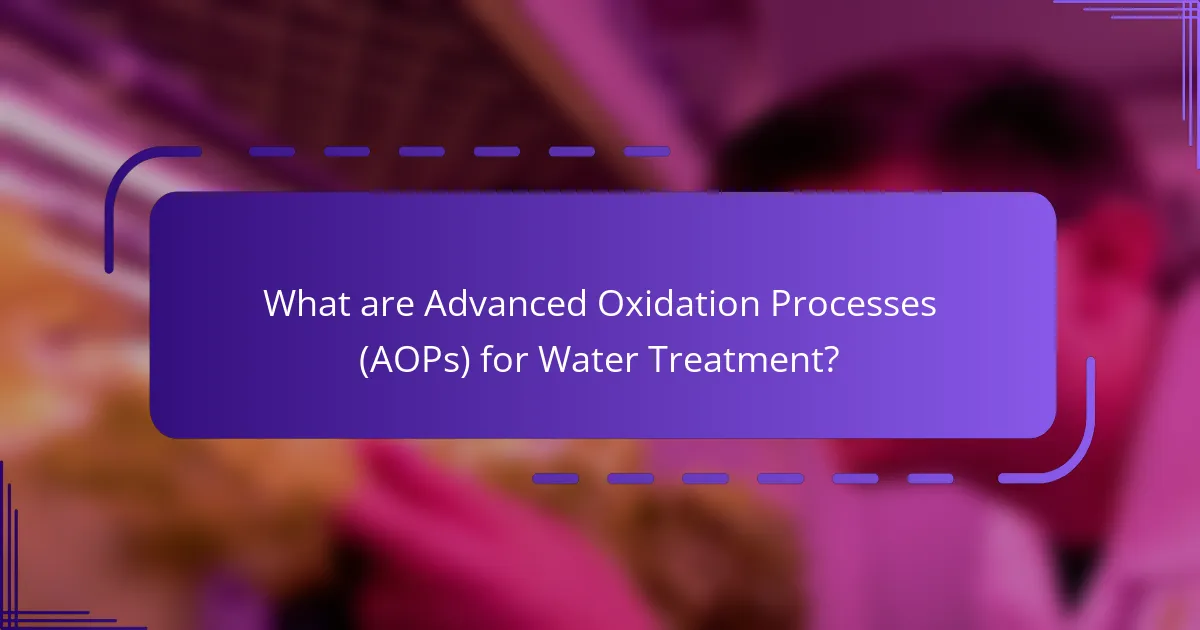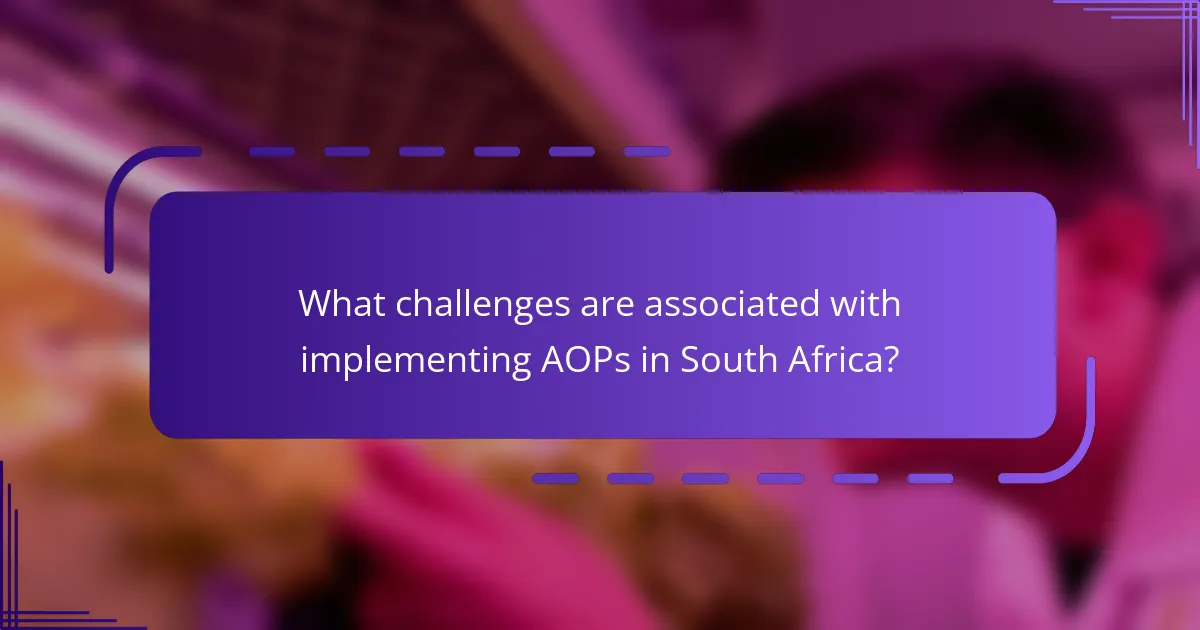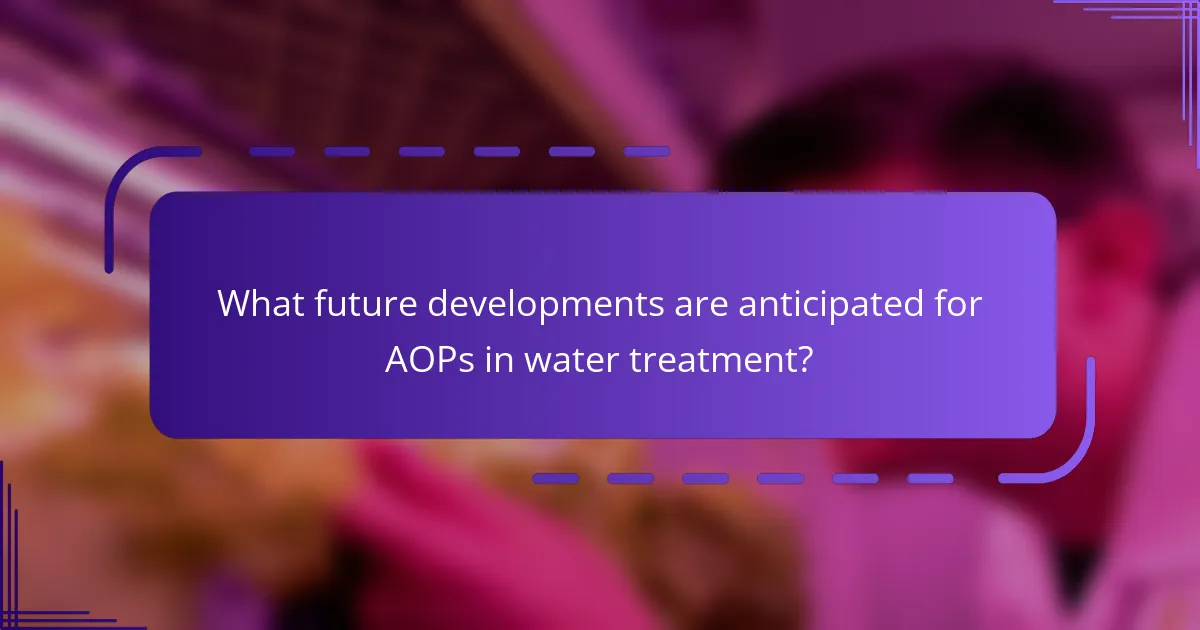Advanced Oxidation Processes (AOPs) are innovative water treatment technologies that utilize strong oxidants, such as ozone and hydrogen peroxide, to effectively remove contaminants from water through the generation of hydroxyl radicals. AOPs have demonstrated high removal rates for various pollutants, making them particularly suitable for treating wastewater and industrial effluents. However, the implementation of AOPs in South Africa faces challenges, including high capital costs, the need for specialized training, and limited access to reliable energy sources. Future advancements in AOPs are expected to enhance their efficiency and reduce operational costs, with potential developments in catalyst materials, renewable energy integration, and monitoring technologies, indicating a promising outlook for sustainable water treatment solutions in the region.

What are Advanced Oxidation Processes (AOPs) for Water Treatment?
Advanced Oxidation Processes (AOPs) are advanced water treatment technologies. They utilize powerful oxidants to remove contaminants from water. AOPs typically involve the generation of hydroxyl radicals. These radicals can effectively degrade organic pollutants. Common oxidants used in AOPs include ozone, hydrogen peroxide, and ultraviolet light. AOPs are particularly effective for treating wastewater and industrial effluents. Studies have shown that AOPs can achieve high removal rates for various contaminants. For instance, research indicates that AOPs can reduce chemical oxygen demand (COD) by over 90%.
How do Advanced Oxidation Processes work in water treatment?
Advanced Oxidation Processes (AOPs) work by generating highly reactive hydroxyl radicals to degrade pollutants in water. These processes typically involve the combination of oxidants such as ozone, hydrogen peroxide, and ultraviolet light. The generated hydroxyl radicals effectively oxidize organic contaminants, breaking them down into less harmful substances. AOPs are particularly effective against persistent pollutants that are difficult to remove using conventional methods. Studies show that AOPs can achieve over 90% removal efficiency for various contaminants. The efficiency of AOPs depends on factors like the concentration of oxidants and the nature of the pollutants.
What are the key chemical reactions involved in AOPs?
The key chemical reactions involved in Advanced Oxidation Processes (AOPs) include the generation of hydroxyl radicals. Hydroxyl radicals are highly reactive species that can oxidize organic pollutants in water. AOPs typically utilize reactions such as the Fenton reaction, which combines hydrogen peroxide with ferrous iron. This reaction produces hydroxyl radicals through the decomposition of hydrogen peroxide. Another important reaction is photolysis, where ultraviolet light is used to activate hydrogen peroxide, leading to the formation of hydroxyl radicals. Ozone-based AOPs also generate hydroxyl radicals through the reaction of ozone with water. These reactions are critical for breaking down complex organic contaminants effectively.
What types of contaminants can AOPs effectively remove?
Advanced Oxidation Processes (AOPs) can effectively remove a variety of contaminants. These include organic pollutants, such as pharmaceuticals and personal care products. AOPs also target industrial chemicals, like solvents and pesticides. Additionally, they can eliminate pathogens, including bacteria and viruses. AOPs are particularly effective against recalcitrant compounds that resist conventional treatment methods. Studies have shown that AOPs can degrade contaminants to non-toxic byproducts. This efficiency makes them suitable for diverse water treatment applications.
What are the primary benefits of using AOPs for water treatment?
Advanced Oxidation Processes (AOPs) provide several key benefits for water treatment. AOPs effectively remove organic pollutants and contaminants from water. They achieve this through the generation of highly reactive hydroxyl radicals. These radicals can oxidize a wide range of organic compounds. AOPs can also reduce the concentration of pathogens in water. This leads to improved water quality and safety. Additionally, AOPs can be used in various water sources, including industrial effluents and wastewater. Their versatility makes them suitable for different treatment scenarios. AOPs often require lower chemical dosages compared to traditional methods. This can result in cost savings and reduced environmental impact.
How do AOPs improve water quality compared to traditional methods?
Advanced Oxidation Processes (AOPs) improve water quality by effectively removing organic pollutants and pathogens. AOPs utilize strong oxidants like hydroxyl radicals to break down contaminants. This method achieves higher degradation rates compared to traditional techniques. AOPs can eliminate a wider range of pollutants, including those resistant to conventional treatments. Studies show that AOPs can reduce chemical oxygen demand (COD) significantly. For instance, a study found that AOPs can achieve up to 90% COD removal in industrial wastewater. Additionally, AOPs often require shorter treatment times, enhancing efficiency. Overall, AOPs provide a more comprehensive solution for water treatment challenges.
What cost-saving advantages do AOPs offer in water treatment?
Advanced Oxidation Processes (AOPs) offer significant cost-saving advantages in water treatment. AOPs effectively degrade contaminants, reducing the need for extensive pre-treatment. This leads to lower operational costs. They also minimize the volume of sludge generated, which decreases disposal expenses. AOPs can treat a wide range of pollutants, thus reducing the necessity for multiple treatment systems. This versatility translates into reduced capital investment. Studies show that AOPs can achieve high removal efficiencies, leading to lower long-term treatment costs. Additionally, AOPs often require less energy compared to traditional methods, further enhancing cost-effectiveness.
What are the specific applications of AOPs in South Africa?
Advanced Oxidation Processes (AOPs) are utilized in South Africa primarily for water treatment applications. AOPs effectively remove organic pollutants and pathogens from wastewater. They are employed in municipal wastewater treatment plants to enhance effluent quality. Additionally, AOPs are used in industrial wastewater treatment to address toxic compounds. They also serve in the treatment of groundwater contaminated with pesticides and pharmaceuticals. Furthermore, AOPs are applied in the remediation of drinking water to ensure safety and compliance with health standards. The effectiveness of AOPs in these applications is supported by numerous studies demonstrating their efficiency in degrading complex contaminants.
How are AOPs utilized in municipal water treatment facilities?
Advanced Oxidation Processes (AOPs) are utilized in municipal water treatment facilities to effectively remove contaminants. AOPs generate highly reactive hydroxyl radicals that degrade organic pollutants. These processes can target a wide range of contaminants, including pharmaceuticals and pesticides. Municipal facilities employ AOPs to enhance the efficiency of conventional treatment methods. AOPs can be integrated into existing systems or used as standalone treatments. Studies show that AOPs significantly reduce chemical oxygen demand (COD) levels in treated water. The application of AOPs leads to improved water quality and safety for public consumption.
What role do AOPs play in treating industrial wastewater?
Advanced Oxidation Processes (AOPs) play a crucial role in treating industrial wastewater by effectively degrading organic pollutants. AOPs utilize strong oxidants to produce hydroxyl radicals, which are highly reactive and can break down complex contaminants. This process significantly reduces the toxicity and concentration of hazardous substances in wastewater. Studies indicate that AOPs can achieve removal efficiencies exceeding 90% for many organic compounds. AOPs are particularly effective for recalcitrant pollutants that are resistant to conventional treatment methods. Their application in industrial settings leads to improved effluent quality and compliance with environmental regulations.

What challenges are associated with implementing AOPs in South Africa?
Implementing Advanced Oxidation Processes (AOPs) in South Africa faces several challenges. High capital costs for technology and infrastructure limit widespread adoption. The complexity of AOP systems requires specialized training for operators. Limited access to reliable energy sources can hinder operational efficiency. Regulatory frameworks may not be fully aligned with AOP technologies. Additionally, public awareness and acceptance of new technologies can be low. These factors collectively impede the effective implementation of AOPs in the region.
What are the technical limitations of AOPs?
Advanced Oxidation Processes (AOPs) have several technical limitations. One major limitation is their high operational costs. This includes expenses for chemicals and energy consumption. Another limitation is the generation of harmful by-products during treatment. These by-products can complicate the treatment process and require additional management. AOPs also have limited effectiveness against certain contaminants. For instance, some organic compounds resist oxidation. Additionally, the need for precise control of operational parameters can complicate implementation. AOPs may also require specialized equipment and trained personnel, increasing complexity. These factors can hinder widespread adoption in water treatment applications.
How do operational costs impact the feasibility of AOPs?
Operational costs significantly impact the feasibility of Advanced Oxidation Processes (AOPs). High operational costs can limit the implementation of AOPs in water treatment facilities. These costs include energy consumption, chemical inputs, and maintenance expenses. For instance, energy-intensive processes like ozonation or UV irradiation can elevate operational expenses. If the costs exceed budget constraints, facilities may opt for less effective but cheaper alternatives. Additionally, ongoing maintenance and replacement of AOP components can add to long-term financial burdens. Studies indicate that optimizing energy use and chemical dosage can mitigate these costs, enhancing AOP viability. Therefore, careful cost management is essential for the practical application of AOPs in South Africa’s water treatment landscape.
What regulatory hurdles must be addressed for AOP implementation?
Regulatory hurdles for Advanced Oxidation Processes (AOP) implementation include compliance with environmental standards. AOP technologies must meet the requirements set by South Africa’s Department of Water and Sanitation. Additionally, there are challenges in obtaining necessary permits for construction and operation. The approval process can be lengthy and complex, often requiring extensive documentation. Stakeholder engagement is also crucial, as local communities may have concerns about water quality and safety. Furthermore, existing regulations may not specifically address AOP technologies, creating ambiguity in compliance. These factors collectively hinder timely implementation of AOP systems in water treatment.
How can the effectiveness of AOPs be maximized?
The effectiveness of Advanced Oxidation Processes (AOPs) can be maximized by optimizing operational parameters. Key parameters include pH, temperature, and the concentration of oxidants. Adjusting the pH to optimal levels enhances the reaction rates. Higher temperatures can increase the efficiency of oxidation reactions. Utilizing appropriate oxidant concentrations ensures the effective breakdown of contaminants.
Additionally, the choice of catalyst can significantly influence AOP performance. Catalysts can accelerate reactions and improve the degradation of pollutants. Implementing advanced monitoring techniques can help in real-time adjustments of these parameters. Studies have shown that optimizing these variables can lead to significant improvements in contaminant removal efficiency. For instance, research indicates that maintaining a pH between 6 and 8 can enhance AOP effectiveness.
What best practices should be followed during AOP implementation?
Best practices during AOP implementation include thorough system design and optimization. Properly assessing water quality is essential for effective treatment. Continuous monitoring of process parameters ensures consistent performance. Operator training is critical for safe and efficient operation. Regular maintenance of equipment prevents unexpected failures. Utilizing appropriate catalysts enhances oxidation efficiency. Adapting AOPs to specific contaminants improves treatment outcomes. Documenting processes and results supports compliance and future improvements.
How can monitoring and maintenance enhance AOP performance?
Monitoring and maintenance enhance AOP performance by ensuring optimal operational conditions. Regular monitoring allows for the detection of deviations in process parameters. This includes pH levels, temperature, and chemical concentrations. Timely adjustments can be made to maintain these parameters within ideal ranges. Maintenance activities prevent equipment failures that could disrupt AOP processes. For instance, cleaning and servicing reactors can improve efficiency. Studies have shown that consistent monitoring and maintenance can increase the treatment efficiency of AOP systems by up to 30%. This directly correlates to improved water quality outcomes in treatment applications.

What future developments are anticipated for AOPs in water treatment?
Future developments anticipated for Advanced Oxidation Processes (AOPs) in water treatment include enhanced efficiency and reduced costs. Innovations in catalyst materials are expected to improve reaction rates. Integration with renewable energy sources may lower operational expenses. Advanced monitoring technologies will likely optimize process control. Research into novel AOP configurations aims to increase treatment versatility. Collaboration with nanotechnology could enhance pollutant degradation. Regulatory advancements may drive AOP adoption in various applications. These trends indicate a promising future for AOPs in sustainable water treatment solutions.
How is research advancing the capabilities of AOPs?
Research is advancing the capabilities of Advanced Oxidation Processes (AOPs) by developing more efficient catalysts and optimizing operational parameters. Recent studies focus on enhancing the degradation of organic pollutants in water. For example, research published in the journal “Water Research” by Zhang et al. (2021) demonstrates improved performance of photocatalytic AOPs using titanium dioxide under UV light. Additionally, innovations in hybrid AOP systems combine multiple techniques for greater effectiveness. Research also explores the use of nanomaterials to increase reaction rates and reduce energy consumption. These advancements contribute to the scalability and sustainability of AOPs in water treatment applications.
What innovative technologies are being integrated with AOPs?
Innovative technologies integrated with Advanced Oxidation Processes (AOPs) include photocatalysis, ozonation, and electrochemical oxidation. Photocatalysis utilizes light-activated catalysts to enhance the degradation of contaminants. Ozonation introduces ozone to oxidize organic pollutants effectively. Electrochemical oxidation employs electrical current to generate reactive species for pollutant breakdown. These technologies improve the efficiency and effectiveness of AOPs in water treatment. Studies have shown that combining these methods can lead to higher removal rates of various pollutants, enhancing overall water quality.
How might AOPs evolve to meet future water treatment challenges?
Advanced Oxidation Processes (AOPs) may evolve by integrating innovative technologies and materials. Future advancements could include the use of nanomaterials to enhance reaction rates. Research indicates that nanomaterials can significantly increase the efficiency of oxidants in water treatment. Additionally, hybrid systems combining AOPs with biological treatment may improve overall efficacy. AOPs may also adopt machine learning for real-time monitoring and optimization. Studies show that machine learning can predict treatment outcomes based on historical data. Furthermore, renewable energy sources could power AOPs, making them more sustainable. The integration of solar energy in AOPs has been demonstrated to reduce operational costs. Overall, these advancements aim to address emerging contaminants and regulatory challenges in water treatment.
What practical tips can be applied to optimize AOP usage in water treatment?
To optimize Advanced Oxidation Processes (AOP) in water treatment, ensure proper selection of oxidants. Hydrogen peroxide and ozone are effective choices. Adjust the pH level to enhance the reaction efficiency. A pH range of 6 to 8 is often ideal for many AOPs. Monitor the reaction time to avoid excessive oxidant consumption. Regularly assess the concentration of contaminants to tailor the AOP application. Implement a feedback control system for real-time adjustments during treatment. Utilize pre-treatment methods to reduce organic load before AOP application. This approach can improve overall effectiveness and reduce operational costs.
Advanced Oxidation Processes (AOPs) are innovative water treatment technologies that utilize powerful oxidants to effectively remove a wide range of contaminants, including organic pollutants and pathogens. This article provides an overview of AOPs, detailing their mechanisms, key chemical reactions, and the types of contaminants they can eliminate. It highlights the benefits of AOPs, such as improved water quality and cost savings, while also addressing challenges related to implementation in South Africa. Additionally, the article explores specific applications of AOPs in municipal and industrial water treatment, as well as future developments and optimization strategies for enhancing their effectiveness.